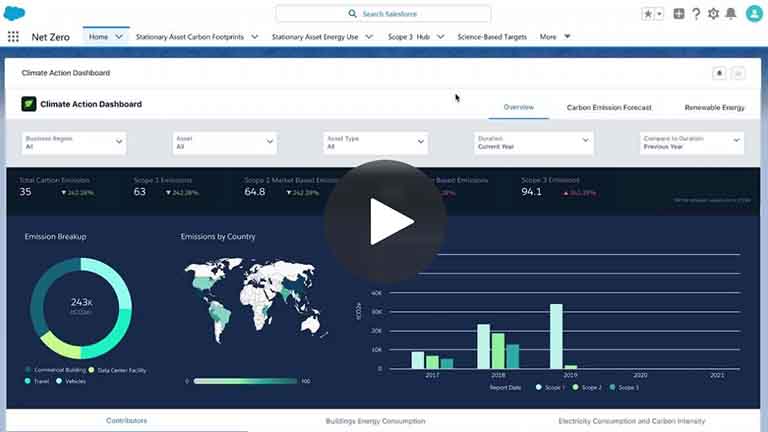The Business Guide to Carbon Accounting
Why should a business account for its carbon?

What is carbon accounting?
Carbon accounting is the systematic approach organizations use to calculate their greenhouse gas (GHG) emissions. This evaluation helps businesses understand their climate impact, set emissions reduction targets, and identify risks and opportunities for the business. In some organizations, a company’s carbon footprint is also known as a “carbon inventory” or a “greenhouse gas inventory.”
Carbon accounting is the foundation for implementing meaningful climate action in your organization. By conducting a thorough GHG emissions inventory, you lay the groundwork for developing targeted carbon reduction strategies that align with and enhance your overall sustainability strategy. The leading framework that businesses use to conduct an emissions inventory is the GHG Protocol.
What are greenhouse gas emissions?
Greenhouse gas emissions trap heat when released into the atmosphere. Carbon dioxide (CO2), methane (CH4), and nitrous oxide (N2O) are the most prevalent GHGs for businesses.
Some amount of GHGs are vital for life on Earth, as they capture heat from the sun, warming the planet while preventing that warmth from dissipating into space. However, over the past 200 years, increasing GHG emissions from the use of fossil fuels has disrupted the delicate atmospheric balance that regulates our climate. This imbalance is leading to extreme global consequences that affect ecosystems, economies, and communities through severe heat waves, large-scale wildfires, intense storms, accelerated sea-level rise, and more.
Because different GHGs have differing levels of impact on the atmosphere, the global community has aligned on the use of a single metric to quantify the impact of all GHGs: carbon dioxide equivalents, or CO2e. The U.S. Environmental Protection Agency defines CO2e as the number of metric tons of CO2 emissions with the same global warming potential as one metric ton of another GHG. In other words, CO2e refers to the impact from all GHGs, normalized and described in terms of CO2 impact. By referring to the impact of all GHGs in terms of CO2e, we can make direct comparisons among various GHGs.

How should you categorize emissions?

Step 1: Assemble Your Team
Facilities management
Accounting
Accounting
Travel
Business Travel
Human Resources (HR)
IT/Infrastructure
Legal
Procurement
Product development
For companies that manufacture products, the design, use, and end-of-life treatment of these products determines their environmental impact. Engage the product design and/or engineering team to ensure accurate data collection and to integrate insights from the carbon footprint analysis back into the product design process to maximize emission reductions.
Next, we'll break down the steps of calculating a GHG inventory in detail, equipping you with the knowledge to navigate the process effectively.

Step 2: Conduct Your GHG Footprint
The first step in calculating your GHG footprint is to determine the boundary of your calculation. Companies often align with the methodology outlined by the GHG Protocol, which explains how companies should identify which assets to include for scope 1 and scope 2 emissions, and how to categorize and frame their scope 3 emissions.
There are three different consolidation approaches:
1. Equity share approach
- Definition: Emissions are accounted for based on the organization's share of equity in an operation.
- Example: If a company owns 40% of a joint venture, it accounts for 40% of the emissions from that joint venture.
Control approaches
2. Financial control approach
- Definiton: Emissions are accounted for if the organization has the ability to direct the financial and operating policies of an operation to gain economic benefits.
- Example: The organization reports 100% of the emissions from operations over which it has financial control, regardless of its equity share.
3. Operational control approach
- Definition: Emissions are accounted for if the organization has the authority to introduce and implement operating policies.
- Example: The organization reports 100% of the emissions from operations over which it has operational control, regardless of its equity share.
These consolidation approaches allow companies to determine the level of control they have over financial assets and operational decisions. Your approach is determined based on the structure and ownership of your organization and its associated entities.
For scope 3 emissions, it’s important to capture emissions data from all your direct, or tier 1, suppliers. Emissions from your suppliers are referred to as upstream emissions. If you produce a finished product or a service that is sold to a customer without further supply chain involvement, you should collect emissions from distribution channels and resellers, also known as downstream emissions. If you produce intermediary goods – such as raw copper that is transformed into copper sheets and then into copper wire – emissions tracking should continue until the product reaches its final form. If all companies do this, that reduces the amount of upstream tracking required.
Regardless of the industry, companies must define and disclose their reporting boundaries. These boundaries may include the GHGs themselves, their sources, the reporting period, the geography, or the business structure or unit.
Once you’ve established your boundaries, you can begin data collection. But collecting the activity data that serves as the foundation for a GHG footprint is not simple. For scope 1 data, you’ll need to find information on any natural gas and diesel used onsite, as well as fuel logs for owned vehicles. Scope 2 data largely consists of electricity and natural gas bills, but finding these can be challenging, especially for smaller offices. Sometimes companies end up needing to fill in the gaps when certain data records simply aren’t available by estimating impact using headcount or square footage.
Scope 3 data is by far the most complex. Many companies collect as much actual data as possible — for example, travel data and spend data — and then rely on estimates to fill in the gaps where source data is especially challenging to capture. Ultimately, it’s most important to do the best you can with the data at your disposal and to commit to continued efforts to improve data quality and consistency over time.
The raw data you gather won't come to you as carbon emissions data. Data for a flight, for instance, might include the price, distance traveled, ticket class, and aircraft type. To translate that into metric tonnes of CO2e requires a series of calculations and conversions. In some cases, there are a few ways to complete these calculations, and it’s important to carefully consider which emissions factors and methodologies will provide the most accurate, complete picture of your GHG emissions.
In general, once you’ve collected your emissions data, we recommend taking the following steps:
- Identify emission factors: Emission factors are coefficients that represent the amount of CO2e released per unit of activity. These factors vary by type of activity, fuel used, and technology, and are often provided by environmental agencies or industry-specific guidelines.
- Apply emission factors: Multiply the activity data by the appropriate emission factors to calculate the emissions for each activity. This will give you the total emissions in units of CO2e, which reflects the global warming potential of different GHGs on a common scale.
- Aggregate emissions: Sum the CO2e emissions from all activities to get the total GHG emissions for the organization or specific operation.
Internal reviews are a critical step in the GHG inventory process. The intent of these internal reviews is to ensure that the data and methodology accurately reflect the company’s actual operations and that the data sets are complete.
Following internal reviews, it's considered best practice to engage an independent third party to complete a full review or audit of the GHG inventory to verify its accuracy. This is very similar to a third-party audit of the financial records and claims of a publicly-traded company. Reviews can be done at two levels: limited assurance and reasonable assurance, with the latter being much more comprehensive and time-consuming. Limited assurance is sufficient for now, but reasonable assurance will eventually become mandatory.

Step 3: Streamline the Process
Companies that follow these steps manually require up to six months to create a trustworthy report on their carbon emissions. For years, companies have relied on spreadsheets, estimations, and incomplete data to create reports that lacked accuracy and failed to provide a comprehensive view of a company’s carbon footprint. Some companies even omitted entire emission categories, deeming the effort required to capture and calculate the data to be greater than the benefit of reporting it. In light of increasing ESG disclosure and reporting requirements worldwide, businesses can no longer cut corners when it comes to reporting on their emissions.
Fortunately, there is an easier, faster, more accurate method for managing your company’s carbon emissions and ensuring compliance. Net Zero Cloud automates the data collection process, offering an accurate and timely view of your carbon footprint. It’s a complete ESG management platform that comes with analytics dashboards, powered by Salesforce’s CRM Analytics (CRMA), that enable users to drill deep into their organization’s energy usage patterns and carbon emissions intensities. This insight is crucial for prioritizing carbon reduction initiatives.
Carbon accounting doesn’t have to be a drain on resources, time, expertise, or budget. Net Zero Cloud enables organizations to quickly track, analyze, and report reliable environmental data to help your company reduce its carbon emissions. It has globally-conforming emission conversion factors built in, allowing you to instantly translate energy use into carbon emissions. The data is also automatically categorized as scope 1, 2, and 3 emissions, so you know exactly where to concentrate your carbon-reduction efforts.

Ready to start accounting for your company’s carbon?
More resources

Meet Net Zero Cloud.

Breitling puts sustainability in the spotlight with Salesforce.



























